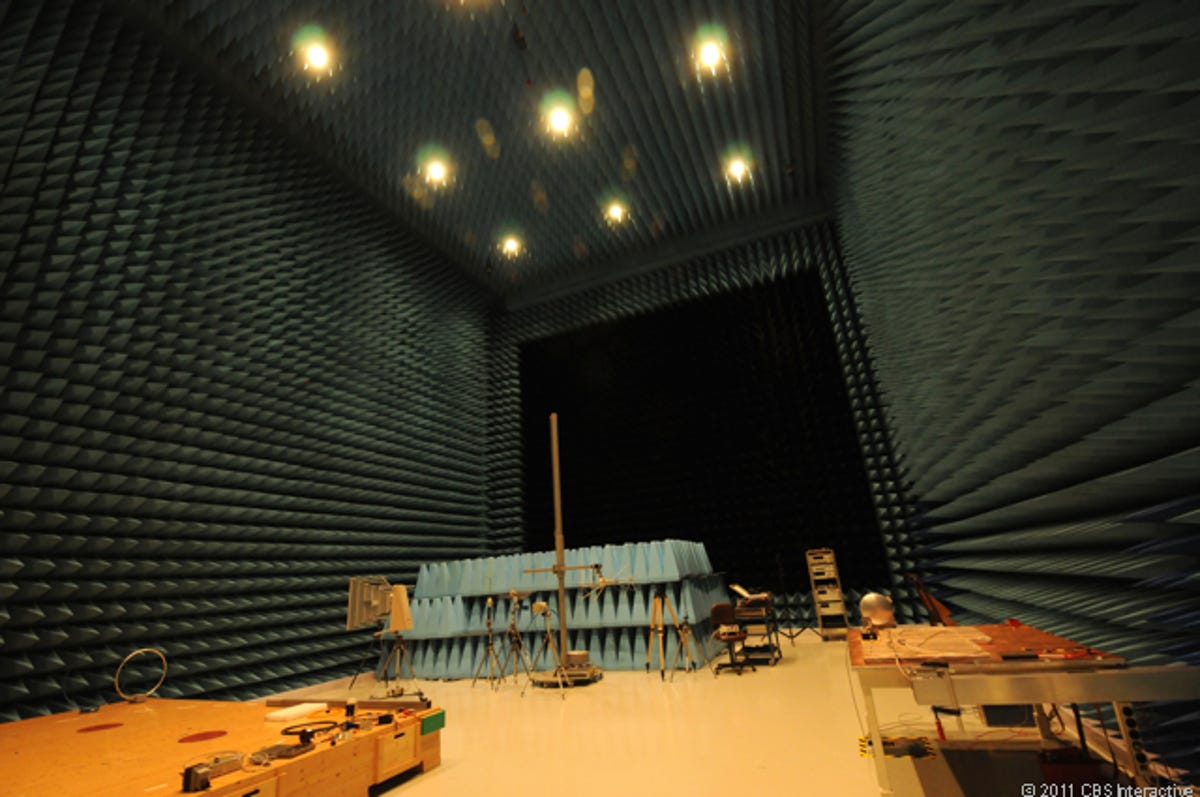For Europeans, space research is rocket science (photos)
Road Trip 2011: At the European Space Agency's ESTEC facility, scientists do some of the world's most advanced space research.

Electromagnetic Compatibility Chamber
NOORDWIJK, The Netherlands--To most Americans, NASA may be the only space research agency worth talking about. But across the pond, some very serious research is being done by the European Space Agency (ESA), a consortium run by 18 countries. And nowhere at ESA is that more true than at the organization's ESTEC (European Space Research and Technology Center) here.
ESTEC features a number of components, and its major duties include development and oversight of all kinds of ESA missions--telecommunications, science, human spaceflight, Earth observation, exploration, and satellite navigation; overseeing the development of space systems and associated technologies; running a test center for spacecraft, and associated engineering labs; and working for the European space industry, and with other space agencies around the world.
This is the Electromagnetic Compatibility chamber in ESTEC's Test Center. It is a Farraday Cage used to measure all electrical properties of equipment being tested in a clean environment.
EMC cones
These are cones in the Electromagnetic Compatibility Chamber. They are crucial for isolating electrons in the room when measurements are being done.
Acoustic chamber
This is the Acoustic Chamber at ESTEC's Test Center. It is employed to reproduce the noise made by rockets in order to evaluate whether satellites or other space-bound specimen can survive the intense sounds of a launch.
Big speaker
This is the biggest of four large speakers in the Acoustic Chamber. Measurements will be conducted for about one or two minutes, approximately the amount of time that the most intense noise of a launch lasts. The noise can create vibrations strong enough to damage a satellite or other device, and it's better to learn what damage will happen in a test center than in space after an expensive launch.
Dummy satellite on shaker
Another major feature of the Test Center at ESTEC is its shaker. This is used to evaluate whether satellites or other specimen are capable of handling the shaking produced during a powerful launch. Though there are other shakers located throughout Europe, this one is used when ESA customers--often telecommunications companies testing satellites--can't find another one big enough. Here, we see a dummy satellite on top of the shaker.
Fuselage on shaker
Here, we see an airplane fuselage that is ready to be moved onto the ESTEC shaker. This is a prime example of how non-space industries use the shaker--another shaker big enough to evaluate the worthiness of the fuselage couldn't be found outside ESTEC.
Small space simulator
This is ESTEC's Small Space Simulator, a smaller version of the facility's Large Space Simulator (LSS). The simulators are used to test spacecraft in realistic space conditions, and the main difference between LSS and the SSS is that the latter has no sun simulator.
Inside the Small Space Simulator
This is a look inside the Small Space Simulator, one of the largest vacuum chambers in all of Europe.
Drop tower
This is a scale-model drop tower in ESTEC's ERASMUS human spaceflight section. The drop tower is used to measure the effects on various experiments of several seconds of microgravity.
ISS model
This is a scale model of the International Space Station, found in the ERASMUS human spaceflight section at ESTEC.
Columbus
The ESA's major contribution to the International Space Station was its Columbus module, which offers astronauts aboard the ISS a series of tools for various experiments. Here, we see a mockup of Columbus from the outside.
Columbus mockup interior
This is the interior of the mockup of Columbus, as seen at ESTEC.
Glove box
This is a replica of the glove box ESA provided for use on Columbus on the ISS. The glove box is used for keeping scientific experiments 100 percent uncontaminated.
Exercise facility
Columbus includes an exercise bike and some other equipment that are used by astronauts aboard the ISS.
Eurobot
This is the Eurobot Ground Prototype, a mockup of a rover the ESA is anticipating may be sent to the moon or, someday, Mars.
Parabolic flight trainer
This is ESTEC's parabolic flight trainer. It is used to help train those who will be taking parabolic rides on a plane for the conditions they will encounter. Such flights are useful for conducting experiments with microgravity.
Demonstrating flexible exoskeleton
In this picture, Joao Rebelo of ESTEC's Robotics and Haptics Labs demonstrates a new kind of exoskeleton that is designed to allow people of many different body heights and types to practice controlling a robotic hand that is located elsewhere.
Trying the exoskeleton
Here, CNET reporter Daniel Terdiman tries out an exoskeletal arm that is used to practice controlling a robotic hand. This model can control a digital version of the distant hand, meaning that the user can try to manipulate "objects" on a screen. The exoskeleton has built-in haptics, which offer force-feedback.
Centrifuge
This centrifuge provides up to 20G forces for use on science experiments that can last minutes, days, or even weeks.

